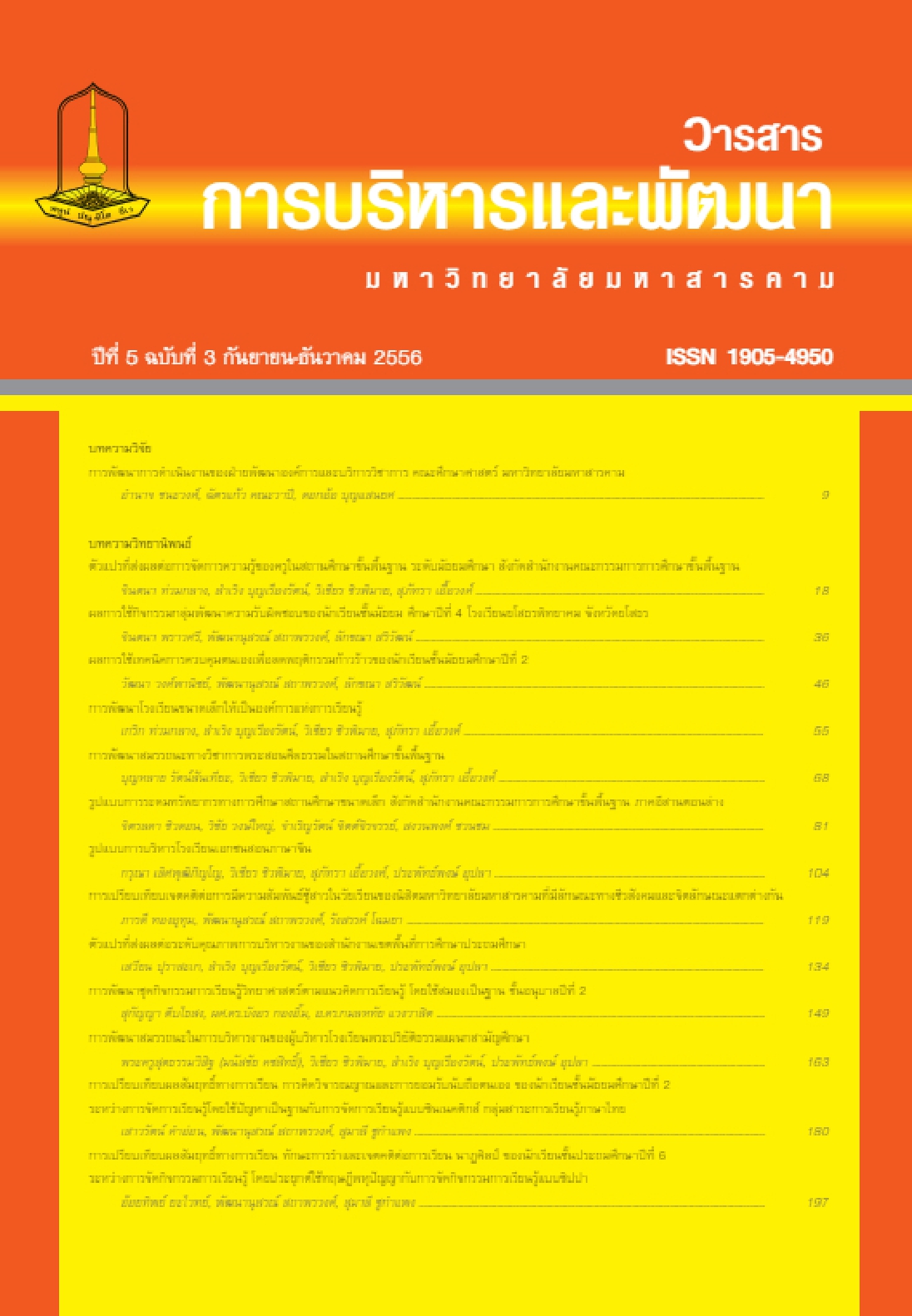An administrative model of Chinese-teaching private school.
Main Article Content
Abstract
The purpose of this research was to study the conditions and problems of administration Chinese-teaching private school in Thailand and to develop a model of administrative of Chinese- teaching in private school. Method of the research comprises of five steps: 1) Studied and analyzed the Mc Kinsey 7s framework, National education plan, ways to start up education development plan of education organization, standard national of education (2006), standard evaluation by the Office of National Education Standards and Quality Assessment (Public Organization). 2) Conducted in-depth interviews of eight specific public figures with knowledge and expertise regarding Chinese-teaching private school management. 3) Arranged intensive group discussions where by nineteen specialists scrutinized the hypothetical model to verify its validity and reliability and then upon the model of administrative Chinese-teaching private school towards more complete in details. 4) Implemented the complete administrative model of Chinese-teaching private school which had been reliably validated by the specialists from step no.3 for its accuracy suitability, possibility and can be put into practice beneficially at Huakhiew Wittayalai school, Xingmin school and Bunyawittayakarn school, which large size school, medium size school and small size school. Experiment revealed a of administration Chinese private school as quality was appropriate, beneficial and possible and can bring about to the quality Chinese private school. By three schools, there is an opinion that; a model of administrative Chinese private school was suitability is valuable x̅ = 4.60 the advantage is valuable x̅ = 4.57 the possibility is valuable x̅ =4.48 and lead consider as the following a model of administrative Chinese-teaching private school revealed. Consider the following aspects. (1) Suitability part: A model of Administrative strategy, Managed by the principles of good governance Decentralized to the operational level. Skill to motivate staff to work hard. Are most appropriate. Followed by the skills required in the administration of the administrator. Understand school policies. Skills of Academic Administration. Personnel, Strategies to restructure the school. Decentralization Responsibility to The Charity Commission administrator and staff. A practical guide to show authority. Chain of command. (2) Advantage part: strategy to development school, set strategic plan, strategy into action, the most useful According to the teachers and administration. Followed by a structured school strategy in the management structure of a work, the clear command line. The operation manual to show power of attorney and the system of administrative. The system of the management structure. The external quality assurance system. many benefits respectively (3) Possibility part: strategy to development school, to control strategy is the most possibility. Followed by the selection of personnel to work in school, cooperate, unity, Relationship, Sacrifice, Patient, Discipline, and strategies to restructure the school. In order to the management system focused on all parties involved in the management of the many possibilities. In conclusion, an administrative model of Chinese-teaching private school. That researchers have developed can be used as a model for the management of Chinese-teaching
private schools. 5) Updating of data from experiments in the step four to writing the research report. An Administrative model of Chinese – teaching private school composes 7 elements. (1) develops school strategy. (2) School structure’s strategy. (3) School administration system. (4) School administration style. (5) Administration
Downloads
Article Details
References
Chinese Studies Center, Institute of Asian Studies, Chulalongkorn University. (2008). “Chinese Language Teaching in Thailand at the Primary and Secondary Education Levels”. 1st edition. Bangkok: Sri boon computer Printing.
Chinese Studies Center, Institute of Asian Studies, Chulalongkorn University. (2008). Education Standard and Quality Assessment of Basic education. 4th edition. Bangkok: Jud Thong Printing Limited.
Chinese Studies Center, Institute of Asian Studies, Chulalongkorn University. (2008). Memorandum of Teaching Chinese Language in Thailand. 1st edition. Bangkok: Sri som boon computer printing.
Chinese Studies Center, Institute of Asian Studies, Chulalongkorn University. (2008). National Education Act B.E.2542 (1999) and Amendments (Second National Education Act B.E.2545 (2002)). Bangkok: Prik Wan Graphic Co.ltd.
Chinese Studies Center, Institute of Asian Studies, Chulalongkorn University. (2002). National Education Plan. (2002-2006): Conclusion edition. Bangkok: Prik Wan Graphic Co.ltd.
Chinese Studies Center, Institute of Asian Studies, Chulalongkorn University. (2008). Outside System Education Learning Chinese Language in Thailand. [Online]. – Retrieved 20 February 2011, from http://www.thaiworld.org/ th/include/answer_search.php?question_id=838 (in Thai)
Masuntisuk, Ronnaphol. (2008). Chinese Language Teaching in Thailand at the Primary and Secondary Education Levels. [Online]. –Retrieved 21 July 2009 from http:// www.csc.ias.chula.ac.th.
Office of the Permanent Secretary Ministry of Education. (2011). Government Action Plan for Fiscal Year 2011 Department of Policy and Strategy. Bangkok.
Office of the Permanent Secretary Ministry of Education. (2011). Strategies to promote the participation of the private sector in the provision of basic education. (Copy Document).
Office of the Permanent Secretary Ministry of Education. (2011). The Direction of Development in the Education in The National Economic and Social Development Plan The Tenth Plan (2007-2011) Consistent with the National
Education Plan. (2002-2006).1st edition. Bangkok: Chulalongkorn University Printing House.
Sangthongkam, Wirut. (2000). McKinsey & Company. [Online]. - Retrieved 20 July 2011, from http://www.gotomanager.com/news/details.aspx?id=614 (in Thai)
Special Policy School Unit, Office of the Private Education Commission. (1991) Cabinet documents, The Policy of Teaching Foreign Languages and Teaching Chinese to Comply with Current Conditions.
Special Policy School Unit, Office of the Private Education Commission. (2009). Private Schools Act 2008. Bangkok: Office of the Welfare Promotion Commission for Teachers and Education Personnel Printing House.
Special Policy School Unit, Office of the Private Education Commission. (2009). The importance of learning Chinese Language in Thailand. - Retrieved 15 September 2009, from http://www.bloggang.com/ (in Thai) Spencer, B.A. (1994). Models of Organization and Total Quality Management Review. 19 (3): 446-471

